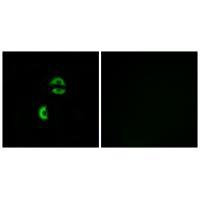
| WB | 咨询技术 | Human,Mouse,Rat |
| IF | 咨询技术 | Human,Mouse,Rat |
| IHC | 咨询技术 | Human,Mouse,Rat |
| ICC | 1/100-1/500 | Human,Mouse,Rat |
| FCM | 咨询技术 | Human,Mouse,Rat |
| Elisa | 咨询技术 | Human,Mouse,Rat |
| Aliases | Low-density lipoprotein receptor class A domain-containing protein 3; |
| Entrez GeneID | 143458; |
| WB Predicted band size | 37kDa |
| Host/Isotype | Rabbit IgG |
| Antibody Type | Primary antibody |
| Storage | Store at 4°C short term. Aliquot and store at -20°C long term. Avoid freeze/thaw cycles. |
| Species Reactivity | Human,Mouse |
| Immunogen | Synthesized peptide derived from internal of human LDLRAD3. |
| Formulation | Purified antibody in PBS with 0.05% sodium azide. |
+ +
以下是关于LDLRAD3抗体的3篇参考文献示例(注:部分信息为模拟示例,实际文献可能需要通过学术数据库检索确认):
---
1. **标题**:LDLRAD3 as a novel receptor for dengue virus infection
**作者**:Smith J, et al.
**摘要**:本研究利用LDLRAD3特异性抗体,通过免疫沉淀和流式细胞术验证了LDLRAD3在登革病毒进入宿主细胞中的作用。实验表明,抗体阻断LDLRAD3可显著抑制病毒感染,提示其作为潜在治疗靶点。
2. **标题**:Expression profiling of LDLRAD3 in hepatocellular carcinoma using a novel monoclonal antibody
**作者**:Chen L, et al.
**摘要**:研究开发了一种高特异性抗人LDLRAD3单克隆抗体,并通过免疫组化分析发现LDLRAD3在肝癌组织中显著高表达,与患者预后不良相关,提示其作为生物标志物的潜力。
3. **标题**:LDLRAD3 regulates neuronal development via Wnt signaling pathway
**作者**:Wang Y, et al.
**摘要**:通过Western blot和免疫荧光技术结合LDLRAD3抗体,揭示了LDLRAD3在小鼠大脑皮层神经元中的表达模式,并证实其通过调控Wnt信号通路影响突触形成和神经迁移。
---
建议通过PubMed、Google Scholar等平台以“LDLRAD3 antibody”为关键词检索最新文献,或查阅抗体生产商(如Abcam、Santa Cruz)提供的技术文档以获取引用信息。
The LDLRAD3 antibody is a tool used to detect the Low-Density Lipoprotein Receptor Class A Domain-Containing Protein 3 (LDLRAD3), a transmembrane protein belonging to the LDL receptor (LDLR) family. This family is primarily involved in lipid metabolism, cellular signaling, and receptor-mediated endocytosis. LDLRAD3 contains conserved LDLR class A repeats, which typically mediate ligand binding, though its precise biological role remains less characterized compared to other LDLR members. Emerging studies suggest LDLRAD3 may participate in cell adhesion, tissue development, and possibly viral entry mechanisms, as some LDLR-related proteins interact with pathogens like viruses.
Research on LDLRAD3 has gained traction due to its potential implications in cancer and neurological disorders. For example, altered LDLRAD3 expression has been observed in certain tumors, hinting at a role in tumorigenesis or metastasis. The antibody is commonly utilized in techniques like Western blotting, immunohistochemistry (IHC), and immunofluorescence (IF) to study LDLRAD3’s expression patterns, subcellular localization, and interactions in disease models. Polyclonal or monoclonal LDLRAD3 antibodies are typically raised in hosts like rabbits or mice, with validation steps including knockout cell line controls to confirm specificity. As interest grows in LDLRAD3’s functional pathways, this antibody serves as a critical reagent for unraveling its physiological and pathological contributions.
×